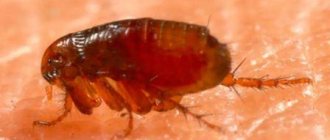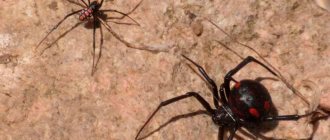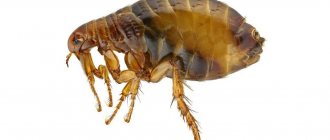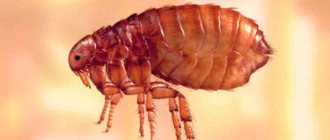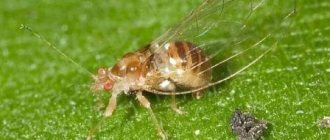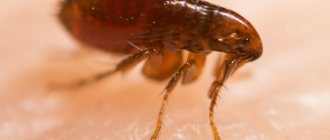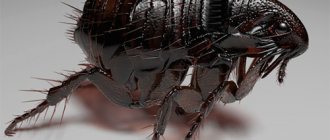Rat fleas get their name because they often live on small rodents. Under favorable conditions, parasites can attack larger warm-blooded animals and even humans. Such fleas are extremely dangerous because... often act as carriers of various infections.
If mice or rats have brought these insects into an apartment or house, you should use chemical insecticides and folk remedies to eliminate the parasites and prevent their reappearance.
Pets can carry insects from the street.
General information about rat fleas
Rat fleas are not a separate species of blood-sucking insects. These are parasites that have adapted to life on rodents. They are transmitted from adult rats and mice to young animals. Thus, many generations of insects live only on rodents.
At the same time, under certain conditions, a flea that has lost its original owner can easily move to another warm-blooded animal covered with fur. The parasite does not live on humans, but is able to feed on his blood.
What they look like: appearance
Scientists distinguish 2 types of rat fleas: southern and European. These insects have minor external differences. The body length of the European flea rarely exceeds 2.5 mm.
It has a dense chitinous coating of dark brown or black color. The insect's body shape is round. An adult can jump to a height of up to 25–30 cm. This species of insect is considered less dangerous and lives less and less on wild rodents.
The now common southern fleas originally lived on warm-blooded animals, found in nature only in the tropics and subtropics.
The expansion of the range of parasites was facilitated by the activities of merchants transporting goods by sea. This type of flea is characterized by larger sizes. The length of the insect is 3.5–4 mm, the body has a flattened shape. The chitinous shell of the flea is brown.
Both types of rat fleas have 3 pairs of legs. The limbs are located on both sides of the thoracic segments. The middle and front legs are quite short.
They are designed to move in the fur of a warm-blooded animal and attach to the skin for nutrition. The hind limbs have longer segments of the tibia and femur. Thanks to this structure of their legs, fleas can make long jumps.
On the head of the insect there are small mustaches and small round-shaped eyes. The piercing-sucking oral apparatus is represented by the lower and upper jaws, lips, equipped with small probes. The flea egg is white or yellowish. The larva looks like a small worm, the length of which does not exceed 3 mm.
Fleas can jump to a height of 30 cm.
Lifestyle
In the process of adapting to life on small rodents, fleas acquired some behavioral characteristics. When examining the fur of a wild rat, it is difficult to detect adult rats.
Fleas try to settle in nests where they have constant access to food. Parasites use rodents as food. After consuming blood, they jump off them and hide in the litter, thus trying to protect themselves from the teeth of mammals.
An adult female lays 350–370 eggs during her life, 5–6 eggs every day. Their development takes 4–9 days depending on the ambient temperature. She does this in the nest litter.
After hatching from the egg, the larva begins to feed on plant debris, dried blood debris and excrement. This stage of parasite development takes 9–16 days.
The larva goes through 3 molts. Then pupation and metamorphosis into an adult with a dense chitinous cover occur. The most comfortable environmental conditions for fleas are: air humidity up to 75% and temperature +21…+23°C. The insect can go without food for up to 14 days.
Maliciousness
Fleas can feed on more than just rat blood. When they lose their original host, these insects attack other warm-blooded animals.
The southern variety of fleas poses the greatest danger to humans. These parasites, unlike their relatives, do not inject an anesthetic enzyme into the wound, so their bites are quite unpleasant.
In addition, the affected area of the skin subsequently becomes inflamed and red. The person begins to experience severe itching. In rare cases, soft tissue swelling and the formation of a purulent focus are observed.
With multiple bites, people often have complaints about:
- headache;
- inflammation of the lymph nodes;
- neurological disorders;
- deterioration of general condition.
These reactions are due to the high toxicity of insect saliva. Southern fleas are more often carriers of life-threatening diseases.
Features of the species and habitat
The highest concentrations of rat fleas are observed in tropical and subtropical regions, but some individuals successfully migrate throughout the world. The insect easily adapts to difficult conditions and can do without food for a long time.
The appearance of the parasite is not much different from other representatives of the order - dog or cat fleas. The body of an adult does not exceed 4 mm in length. The insect moves using 6 legs, two of which are jumping. The oval-shaped body is flattened, which, together with a durable chitinous shell, protects the flea from physical damage.
Flea
For reference! The optimal microclimate for the successful development of the parasite is a temperature of about +25⁰C with a humidity level of 60 to 75%. In one clutch, a female can have up to 400 eggs, which contributes to the rapid reproduction of the pest.
Do decorative rats have fleas?
Such rats can become victims of southern fleas. When parasites enter a human home, they primarily attack rodents, both wild and domestic.
If the infection is severe, the pet may die. If the parasite does not find a rat, hamster or mouse, it will attack dogs, cats, birds and even humans.
Most often, these insects live in houses and bedding of pets, as well as in old carpets. Parasites are able to hide in areas where trash accumulates, garbage chutes and basements.
Southern fleas can live on pet rats.
Preventing fleas
It is much easier to prevent the appearance of parasites than to fight them for weeks or even months. Particular attention should be paid to pets: periodically examine them and bathe them with a special shampoo.
Preventive measures:
- When you get home, wash your shoes.
- Avoid places where pests accumulate: landfills, trash cans.
- Do not contact with wild animals.
- Clean the house regularly.
If for some reason it is impossible to avoid visiting places with a high concentration of parasites, then you should use aerosol repellents such as Mosquitol or Ultratone. You can plant chamomile or geranium near the house, and in the case of an apartment, get a flowerpot. The specific smell will repel pests.
Ways of rat fleas entering homes
Wild rodents are attracted to human homes because... here they can find enough food. Mice and rats especially love houses and apartments where sanitary standards are not observed and household waste remains for a long time. Once in a human home, a rodent can bring parasites there on its fur.
The flea does not understand that it is not in the nest, so after consuming a sufficient amount of blood, it jumps off the owner, remaining in the apartment.
In addition, the insect can cling to people's clothing and shoes and animal fur. Thus, a person himself or his pets can bring the parasite into the house. Insects can enter the room through loggias, balconies, cracks in floors and entrance doors.
How parasites enter living spaces
There are several options for how rat fleas can get into an apartment.
- Through pets. If your pet is walking outside, these blood-sucking insects can jump on them from the ground or other cats and dogs. Therefore, it is advisable to ensure that they do not come into contact with animals that live in the yard permanently.
- With the help of people. Since fleas can parasitize people, they can easily move onto them by hiding in the folds of clothing.
- On one's own. These insects are distinguished by their speed of movement and jumping height. Very often they live in the basements of apartment buildings, and from there they can easily enter residential premises. To avoid this, it is important to ensure that the management company regularly carries out disinsection and deratization in the building.
- From the neighbors. If fleas are infested in adjacent apartments, they can easily penetrate through cracks in the ceilings into adjacent rooms. Only frequent cleaning of the apartment can prevent such developments. If parasites have nowhere to lay eggs, they will not be able to settle for a long time.
Danger to humans
The main danger of flea bites for humans is not the bites themselves, although they are quite painful.
These parasites are carriers of dangerous infections such as:
- hepatitis;
- typhus;
- plague;
- brucellosis;
- encephalitis;
- anthrax;
- salmonellosis;
- tularemia, etc.
In addition, flea bites carry a high risk of helminth infection. Some people have an individual intolerance to the enzymes contained in the saliva of the parasite. This can trigger the development of severe allergic reactions.
Symptoms of infection
Characteristic symptoms often occur with multiple rat flea bites.
In this case, the following manifestations are observed:
- swelling of the bite site;
- severe itching;
- pain;
- dryness and ulcers in the mouth;
- dizziness;
- increased body temperature;
- anxiety;
- labored breathing.
A person scratches the damaged surface vigorously, which increases the risk of infection by bacteria and viruses contained in the parasite’s saliva, as well as additional infections. In this case, accompanying symptoms characteristic of a particular disease appear.
Flea bites can cause irritation and itching.
Consequences of a bite
They depend on the type of infection transmitted to a person through the saliva of the parasite. Thus, when infected with typhoid, salmonellosis, brucellosis, etc., severe disturbances in the functioning of the gastrointestinal tract and intoxication of the body are observed.
Anthrax leads to the formation of dangerous defects on the skin.
Encephalitis can cause permanent neurological impairment. In severe cases of diseases transmitted through the saliva of the parasite, the risk of death is high.
Appearance
These insects are divided into varieties; the most common type of flea is the southern rat flea.
With the naked eye it is impossible to distinguish them from other relatives - dogs, cats and domestic ones. Only a specialist can determine the species under a microscope.
The rat flea looks similar to other representatives of the genus: the body has an elongated shape, flattened on the sides, the back part is raised due to long jumping limbs.
It is covered with chitinous cover and has a dark brown color. Length – from 3 to 5 mm.
Treatment options
When identifying traces of insect bites, you need to properly treat the affected area:
- Wash skin thoroughly with warm water and soap.
- Treat the bite area with an antiseptic.
Suitable for this:
- hydrogen peroxide;
- iodine;
- brilliant green;
- miramistin;
- alcohol lotion, etc.
If signs of an allergic reaction appear, you should take an antihistamine. If your body temperature rises and your lymph nodes become enlarged, consult a doctor.
Symptoms of infection
Flea bites cannot be ignored - when the proboscis is inserted under the skin, they do not inject any anesthetic enzymes, like other blood-sucking insects.
In addition, the wounds are very visible externally - the parasites cause irritation on the skin, which is accompanied by itching, swelling, and redness. Most often, it is bites on a person that reveal their presence in the house.
If a rat has fleas, scratching marks, bald spots and scabs will be noticeable on its body. The pet will jump sharply from time to time, reacting in a similar way to painful bites.
Other pets exhibit the same symptoms as when infected with other types of fleas - nervousness, constant scratching of the skin, especially in hard-to-reach places.
Pet treatment
To get rid of fleas faster, you first need to rid your pets of them. This will deprive the insects of food. Shampoo or spray to kill fleas living in the animal’s fur, as well as drops, will help with this. Then you should put a special collar on your pet, which will repel fleas and prevent re-infestation.
Drops
Drops containing an insecticide are applied to the animal’s withers. Drugs produced in this dosage form are safer and more effective.
Before treating your pet, you should not bathe it for 3-4 days so that the fatty film on the skin is not disturbed. If you apply the drops immediately after washing, there is a high probability that the drug will not work. The product protects your pet for 3-4 weeks.
The most effective drugs include:
- Rolf 3D;
- Advantan;
- Hartz;
- Stronghold;
- Frontline;
- "Inspector";
- "Bars".
“Bars” is one of the most effective flea medications.
Steps
Part 1
Flea detection
Take a closer look to see if the rat is itching more often than usual.
As a rule, the animal scratches and scratches the flea-infested area of the body quite often and vigorously. In this area, irritation and redness of the skin are observed. Due to constant scratching and flea bites, the skin can become inflamed.
- Bald spots and red crusts may appear on the skin, which also indicates irritation, even if you do not see your pet itching.
- Fleas usually hide in hidden areas of the body. If your rat scratches the belly and armpit area more than usual or has irritated skin in these areas, this may indicate the presence of fleas or another skin irritant.
- The rat may suddenly jump or exhibit other unexpected reactions. This is how the animal reacts to flea bites.
Look for fleas on the rat's body and in its fur.
If the infestation is severe, you will be able to detect the fleas themselves or their excrement. The latter have the appearance of coffee-colored mud in the animal's fur. Take a flea comb or other comb with closely spaced teeth and run it through the rat's fur. Hold the comb close to the skin to catch hiding insects. If there are black dirt-like spots on the comb, these could be fleas or their excrement.
- Have a bowl of soap and water to wash your hairbrush right away.
- Flea droppings and simple dirt can have a similar appearance, especially if you let your pet out into the open air. One way to tell them apart is to wet them with water and see if they turn a reddish-brown color. Flea feces contain blood, which when wetted gives them a red color.
- Adults make up only about 5% of a flea colony. The remaining 95% are eggs, larvae and pupae, which are more difficult to see with the naked eye.
How to properly treat a house
To get rid of fleas in your home, you should start by cleaning:
- Remove all trash and old trash from the premises.
- Remove curtains, bed linen and other home textiles, wash and iron these items.
- Vacuum carpets and upholstered furniture, treat them with a steam generator.
- Be sure to thoroughly wet clean all surfaces.
- Put food in the refrigerator and remove plants and pets from the room.
Before antiparasitic treatment at home, wear gloves, a mask and protective clothing.
Chemicals
Many chemicals, produced in the form of aerosols, powders and sprays, effectively destroy not only adults, but also eggs.
Effective means include:
- Raptor;
- Raid;
- “Carbozol”;
- “Dichlorvos”;
- “Combat”;
- “Karbofos”;
- “Clean house”, etc.
Spray for cleaning the house from insects.
Emulsions
They are more often used for treating basements and staircases. They act slowly, but within 5-7 days they cause the death of the entire flea population.
Effective drugs produced in this dosage form include:
- "Executioner";
- "Tetrix";
- “Cucaracha”;
- “Fufaron”;
- Get.
Emulsions are intended for treating premises against fleas.
Natural insecticides
These include pyrethrum. It is obtained from an extract of chrysanthemum extract. It has a neurotoxic effect on insects. The drug is available in the form of sprays and powder.
In addition, boric acid is a natural insecticide. This substance dissolves the chitinous cover and promotes dehydration of the parasite.
Folk remedies
To get rid of fleas, you can use an infusion of wormwood and tansy.
To prepare it, you need:
- Mix 3 tbsp. these herbs that have a specific smell.
- To eliminate it, add 1 tbsp to the herbal mixture. eucalyptus.
- Pour 200 ml of boiling water over it and leave for 12 hours.
- Strain the product, pour it into a spray bottle and treat carpets and all areas where parasites may be hiding.
In addition, you can use a mixture of salt and soda:
- Take these components in equal proportions.
- Scatter the mixture over the carpet and leave for 12 hours. This time is enough to kill adult fleas and their eggs.
- Vacuum the carpet.
Tincture of tansy and wormwood helps in the fight against fleas.
Ways to combat parasites
The most effective method is to call a pest control service to treat the premises. If you decide to get rid of rat fleas in the apartment yourself, then you must adhere to a certain algorithm of actions.
First, you should treat your pets with insecticides. These can be special shampoos, sprays or drops on the withers.
Any product can be easily purchased at your nearest pet store. Then you need to remove children and animals from the apartment for the duration of treatment. The next step is a thorough cleaning of all premises. To do this, you need to vacuum carpets, upholstered furniture, shake out cat and dog bedding, special attention should be paid to baseboards, corners of rooms and the space under furniture where insects and their larvae can hide. Next, be sure to wash the floors in the usual way.
When the cleaning is completed, you can begin treating the apartment with chemicals. Their choice is very large, and there are many formulations that have proven their effectiveness. Many people prefer classic Dichlorvos, especially since a new subtype has been developed that is practically odorless, which is very convenient. In addition to it, there are substances aimed at destroying rat fleas.
Appearance
These insects are divided into varieties; the most common type of flea is the southern rat flea.
With the naked eye it is impossible to distinguish them from other relatives - dogs, cats and domestic ones. Only a specialist can determine the species under a microscope.
The rat flea looks similar to other representatives of the genus: the body has an elongated shape, flattened on the sides, the back part is raised due to long jumping limbs.
It is covered with chitinous cover and has a dark brown color. Length – from 3 to 5 mm.
Why are rat parasites dangerous for humans?
All types of rat parasites live on the surface of the body and on the external organs of the pet. They do not pose a threat to the human body; they cannot live on the body or bite human skin. The exception is one species of rat mite - Ornithonyssus benoiti. In many people, rat pests cause an allergic reaction - you can get severe intoxication with the waste products of ectoparasites.
Allergy symptoms will disappear after treating the rodent and cage with insecticides. Thus, at the first signs of infestation of an ornamental rodent with pests, it is necessary to begin immediate therapy. Otherwise, exhaustion and untreatable diseases may develop, which will lead to death. If you treat the animal and its home in a timely manner, your pet will recover without any consequences.
https://apest.ru/blohi/vidy-bloh/krysinye-blohi/ https://pets2.me/bok/gryzuny/krysy/zdorove-kr/2366-parazity-u-krys.html
